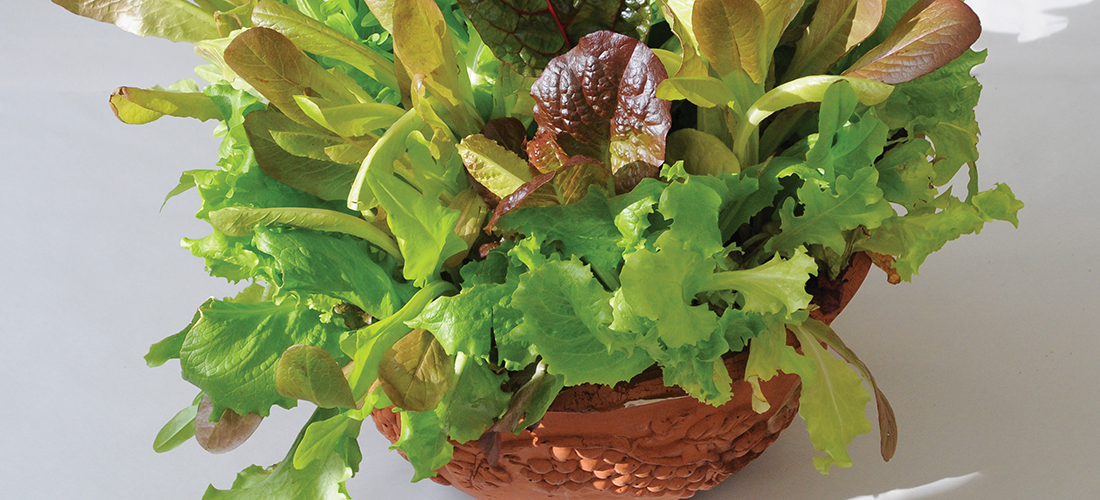
Scratching the winter gardening itch
By Jan Leitschuh
This time of year, produce hunger often creeps in. After the heavy sugar, meat and cream-rich holiday indulgences, we often crave the clean, simple flavors. A squirt of fresh lemon juice. A crushed garlic clove. Fresh, tender young greens.
If salad is wanted, the usual option is to head to the grocery store. A few gardeners may be lucky enough to have a raggedy collard patch or a frost-pounded row of kale or chard nearby, but those are the more hearty greens; best for stewing and steaming, harder to incorporate mature leaves into a fresh salad.
But for the Kitchen Gardener with itchy fingers, the first thought is . . . what can I grow? Well, even in February, there are ways.
Winter gardening guru Elliot Coleman of Maine, famous for his northward winter market garden, calls these long night/cold times “the Persephone days.” One need not be a Greek mythologist to decipher the meaning: tough times for outdoor plants, even in the sunny South.
Clearly, it’s cold enough to inhibit growth, but icy temps are not the only factor. Many growing things require 10 hours of sunlight to flourish. Active plant growth slows down dramatically during the low-light months, even sturdy, cold-hearty items with lesser light demands — greens such as fall-planted spinach or arugula.
Luckily, we gain almost an hour of daylight in February. The Earth, though not fully throwing off slumber, will quicken throughout its second-month days. Eager gardeners may then plant February sugar snap peas mid-month — if brave and willing to replant. It’s normally an excellent late-winter strategy. Peas can come through some nasty hard freezes surprisingly well, especially in our well-drained soils that prevent rot.
Some brave gardeners might even venture to sow some — not all their seeds, but some — Asian greens, fava beans, lettuce, turnip greens, mache, arugula, carrots, chard, green onions, beets or spinach at month’s end. That’s for the eager. The more cautious/time-pressed can wait until later in March.
One fine strategy takes forethought in September. Grow a sturdy fall greens crop to healthy adulthood, then simply protect it from frost with low tunnels of spun fabric, making a handy, backyard fresh market or “living refrigerator” you can dip into at will. Fresh spinach in January? It can happen, but not without care. But, we didn’t do that, did we? The 2016 barn door has already closed. And we’re hungry now.
The solution is easy enough. Grow a bowl of greens now. Indoors. In a bowl, a small window box or pretty container. Use ordinary plastic flowerpots if you want, and tuck them in an old basket with a dish to catch drips. Greens require a bit less light than other veggies, are packed with vitamins K, A and C, have that sweet fresh crunch and offer a satisfying, off-season chlorophyll hit — besides scratching that kitchen gardening itch.
Besides fresh greens, best thing about it? No deer ravages! Sorry, Bambi — go graze the neighbor’s pansies instead.
Start by ensuring your container has a drainage hole and a dish to catch excess water. Folks have grown greens in fancy urns, tin cans, moss-lined mesh circles, old yogurt cups, black nursery pots and more. As long as it holds a small volume of soil — three or four inches, as lettuces are shallow rooted — and has a good drain hole, it will work.
Fill with a simple potting soil, preferably one with a little fertilizer. If you are going to harvest right from the bowl, the plants will need nourishment over their two-month lifespan. Moisten the soil, let it expand and drink for a while. You can also use organic fertilizers, but this is trickier.
You can plant a variety of greens — lettuce, arugula, mache, chard, kale — in your container, but they will have different germination rates. For the most gratification, try a lettuce mix first. Lots of color and variety and similar growth patterns, lettuce should satisfy that salad lust.
Once soil is evenly moist, sprinkle your lettuce seed on the surface. Press the seed into the soil gently with a thumb. Seed-soil contact is critical. Then scatter the slightest dusting of soil atop. Too deep will smother the fine seeds, and too shallow will allow them to dry out. Like Goldilocks, you want it “just right.” Like sprinkling salt on popcorn, use about that much soil.
You’ll need care when watering, or these tiny fine seeds will wash into a clump and compete for space. A daily gentle mist from a household sprayer should suffice. Keep damp but not soaking, and don’t let them dry out. Once plant growth takes off, check soil regularly, as the growing roots will be pulling moisture hard to make new leaves.
A cool room in the house is perfect for germination. It doesn’t need a lot of light until the seeds sprout. Lettuces won’t germinate well above 80 degrees, so skip the water heater or heat pad where you start your tomato, eggplant and pepper seedlings. A sunny windowsill makes a perfect growing spot.
The good news is you can be a slacker on many of these suggestions and still grow a crop.
On pretty, sunny days, you can set your lettuce container outside and let it dress up your porch. On bitter, bone-cracking cold nights, you pull it inside. With the right container, it’s a visual asset as well as a culinary one. I’ve been to spring parties where, in a pretty container, a bowl of greens served as a terrific and heartening buffet or centerpiece.
Baby leaves are the most tender. Thin out the leaves for salads as the container begins to fill out. Just snip a few leaves down low on the stem and add them to your existing salads while waiting. I admit, I often just graze my pots, eschewing bowls and salad dressing. Sweet young greens are delicious in their own right.
Thin the heavy spots, to ensure continued production. When the weather warms, you have options. You can harvest right from the bowl, or break up the party and plant clumps in the garden in later March, when the weather softens. There, you’ve got a head start on spring!
If you plant outdoors, you’ll need to “harden” the young plants off so that they may survive. If you’ve been putting the container outside in the sun on the nice days, you’re practically there anyway. Lettuces are even fairly freeze-hardy, if protected.
Unlike tomatoes, squash, eggplant and other heat lovers that would live in a container during challenging and extended conditions, you won’t be keeping your plants indoors or confined long. Lettuce grows to baby-harvest size in as early as 30 days for some varieties, 45 days for others. Better to harvest early, rather than late, for sweetest taste.
Remember, you can sow directly in the garden about six weeks before the last frost date, which is around mid-April here. In March one can attempt to begin sowing, or replanting, outside. Sow a little every two weeks, rather than all at once.
Cold soil will cause slow germination and growth, so I propose that the avid gardeners, eager for spring, do both. Why choose? Doing both will get you maximum production. You can have your indoor garden and eat it too. PS
Jan Leitschuh is a local gardener, avid eater of fresh produce and co-founder of the Sandhills Farm to Table Cooperative.





